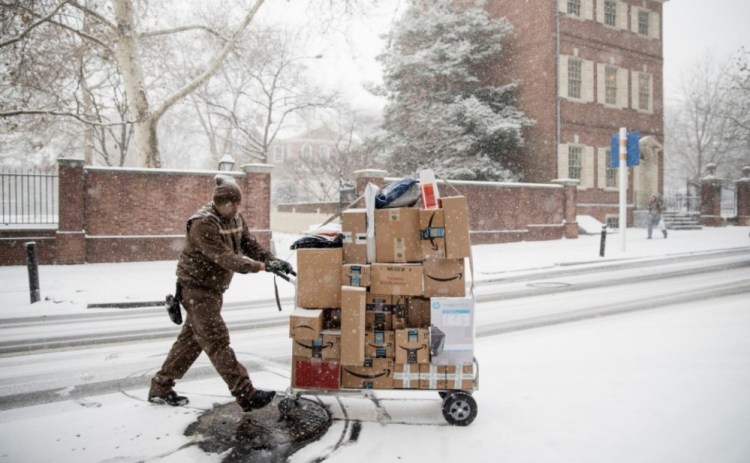The holidays are over, which means it’s time for the annual rush of returns. But instead of flocking to stores, unwanted merchandise in hand, shoppers are increasingly mailing back their ill-fitting sweaters, creating new issues for shipping companies and retailers.
United Parcel Service, FedEx and others are in the midst of what they expect to be a week of record-setting returns as Americans heading to work drop off their boxed-up returns on the way. Consumers are projected to send back roughly $90 billion worth of gifts this holiday season, accounting for nearly one-fourth of the year’s returns, according to Optoro, a Washington-based firm that helps retailers manage the returns process.
“While the day after Christmas used to be reserved for long return lines at department stores, the growth of e-commerce has changed when and how consumers return gifts,” Alan Gershenhorn, chief commercial officer for UPS, said in a written statement.
The company expects to process 6 million returns this week and a record 1.4 million packages on Wednesday alone, which it has dubbed National Returns Day. Overall, UPS estimates it delivered 750 million packages from Thanksgiving Day to New Year’s Eve, up 6 percent from last year. The U.S. Postal Service, meanwhile, says online returns grew 26 percent during the last two weeks of 2017, and it expects that growth to continue into January.

Cynthia Putney, right, and Linda Pierce, in background, brought their returns and exchanges to the J.C. Penney in Mount, N.C.
As consumers do more of their shopping online – e-commerce spending is projected to have exceeded $100 billion this holiday season – they end up returning more, too. An estimated 25 percent to 30 percent of online purchases are sent back, about triple the rate for items bought in-store, according to Worldwide Business Research. For clothing and shoes bought online, the return rate can be as high as 40 percent.
For retailers, the spate of post-holiday returns is driving up expenses and creating new challenges that could undo some of the gains they saw during a brisk holiday season. Early projections indicate holiday sales rose 4.9 percent during the holidays, accounting for the largest annual increase since 2011, according to Mastercard’s SpendingPulse report.
“The real tale of the tape won’t be known until February and March,” Mark A. Cohen, director of retail studies at Columbia Business School, told The Washington Post last week. “Free shipping is enormously expensive. Returns are enormously problematic, especially for e-commerce players.”
Free shipping and returns have become nearly ubiquitous, particularly during the holiday season, as retailers look to keep pace with Amazon.com, Walmart and Target. As a result, nearly half – 49 percent – of the country’s retailers now offer free return shipping, according to the National Retail Federation.
But processing those returns can be a laborious and costly process. Returned items are typically routed to a central warehouse, industry analysts say, where workers process each transaction and decide whether an item should be resold, sent to an outlet store or third-party discounter, or tossed in the trash. Lower-priced goods – typically $40 or less – tend to get discarded, said Jonathan Byrnes, a senior lecturer at MIT’s Center for Transportation & Logistics.
“Returns are one of the most under-managed and most expensive areas in business,” he said. “Retailers don’t know what to do, so they’re basically putting their heads in the sand and hoping it’ll go away.
“A return,” he said, “is a failed sale. And retailers want nothing to do with it.”
Optoro estimates that 5 billion pounds of returned goods will end up in landfills this year as companies struggle to deal with used and damaged items.
Some major retailers, though, have been coming up with solutions to ease the process. Amazon, for example, offers customers store credit right away so they don’t have to wait for their refunds to be processed. Walmart recently improved its mobile app to make it possible for customers to return items at the store in about 30 seconds. And if a shopper wants to return something like shampoo or lipstick, Walmart offers an instant refund on select items without requiring them to bring back the purchase (which would have likely ended up in the trash anyway).
“We know returning an item and waiting for a refund, especially for a product purchased online, isn’t always seamless,” Daniel Eckert, a senior vice president at Walmart U.S., said in a written statement. “We’ve completely transformed the process for our customers.”
Send questions/comments to the editors.



Success. Please wait for the page to reload. If the page does not reload within 5 seconds, please refresh the page.
Enter your email and password to access comments.
Hi, to comment on stories you must . This profile is in addition to your subscription and website login.
Already have a commenting profile? .
Invalid username/password.
Please check your email to confirm and complete your registration.
Only subscribers are eligible to post comments. Please subscribe or login first for digital access. Here’s why.
Use the form below to reset your password. When you've submitted your account email, we will send an email with a reset code.